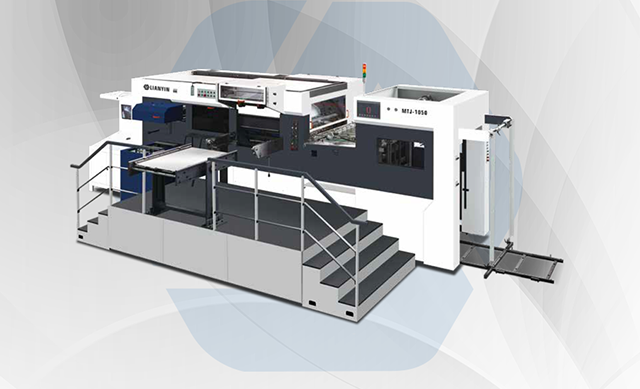How Fully Automatic Hot Stamping Machines Improve Productivity
Fully automatic hot stamping machines are vital equipment in modern manufacturing, offering precision, speed, and consistent quality in stamping operations. By automating the hot stamping process, these machines reduce labor costs, minimize material waste, and increase production efficiency, making them indispensable in industries such as packaging, printing, label production, and luxury goods.
These machines integrate servo-driven feeding, automated foil alignment, and intelligent control systems, enabling manufacturers to achieve high-speed, high-accuracy stamping. Investing in fully automatic hot stamping machines allows companies to streamline workflows, reduce downtime, and maximize output quality.
Automates repetitive stamping tasks, allowing continuous operation
Servo-driven feeding and foil control ensure precise alignment
Reduces operator fatigue and increases throughput
Uniform stamping pressure guarantees consistent results
Minimizes errors and material defects
Enhances product appearance, especially for luxury packaging and labels
Reduces manual labor requirements
Minimizes material waste from misaligned or incorrect stamping
Increases return on investment by optimizing production capacity
Built-in safety systems prevent machine damage and operator injuries
Durable construction ensures long-term performance
Reduced downtime contributes to higher overall equipment efficiency (OEE)

Correct installation ensures optimal machine performance and safety. Follow these steps for a smooth setup:
Prepare the Installation Area
Ensure the floor is level and vibration-free
Allow sufficient space for operator access and maintenance
Verify electrical and pneumatic supply requirements
Position the Machine
Place the machine on a stable foundation
Align it with the production line for smooth workflow
Connect Utilities
Connect the power supply, matching voltage and phase
Connect the air compressor if pneumatic components are used
Ensure grounding for safety
Calibration and Test Run
Set up the control system and touchscreen interface
Adjust foil and sheet alignment
Conduct a trial stamping run with sample sheets to check accuracy
Safety Check
Verify emergency stop buttons and safety guards
Train operators on safe machine operation
Following the installation guide ensures fast deployment and reliable operation, reducing startup issues and downtime.
Understanding technical specifications helps manufacturers choose the right machine for their production needs.
| Parameter | Specification |
|---|---|
| Machine Type | Fully Automatic Hot Stamping Machine |
| Max Sheet Width | 1050 mm |
| Max Sheet Length | 800 mm |
| Material Thickness | 0.3–1.5 mm |
| Stamping Speed | 5–30 m/min (adjustable) |
| Power Supply | 380V, 50Hz, 3-phase |
| Air Pressure Requirement | 0.6–0.8 MPa |
| Control System | PLC with Touchscreen Interface |
| Foil Feed | Automatic, servo-controlled |
| Optional Features | Auto Sheet Detection, Safety Guards, Adjustable Pressure |
Selecting a machine based on production volume and material type ensures optimal performance.
Proper packaging is essential for safe transportation and storage.
| Packaging Component | Description |
|---|---|
| Machine Base | Secured with protective padding |
| Foil Feed Unit | Wrapped in anti-static film |
| Electrical Components | Housed in insulated boxes |
| Accessories | Packaged in labeled compartments |
| Overall Packaging | Wooden crate with anti-vibration supports |
| Shipping Dimensions | 2600 × 1300 × 1600 mm |
| Gross Weight | Approx. 1300 kg |
Adhering to packaging specifications prevents damage during shipping and ensures machines arrive in perfect working condition.
Regular maintenance ensures long-term productivity and reduces downtime.
Clean rollers, stamping heads, and sensors
Remove dust, foil debris, and adhesive residue
Check machine operation for unusual noises or vibration
Lubricate moving parts
Inspect belts, gears, and bearings for wear
Check pneumatic connections and air pressure
Calibrate sensors and control systems
Inspect electrical wiring and safety interlocks
Test stamping accuracy with sample sheets
Deep clean feeding and stamping units
Replace worn components such as stamping dies or foil rollers
Conduct full performance testing
Complete mechanical and electrical inspection
Replace major wear parts
Verify full production speed and stamping accuracy
Following a structured maintenance schedule ensures high uptime, consistent quality, and prolonged machine lifespan.
Hot stamping logos, patterns, and brand marks on folding cartons
Produces high-quality, uniform packaging with minimal waste
Labels, cards, and promotional materials benefit from precise stamping and consistent alignment
Stamping on high-end products like gift boxes and notebooks
Maintains premium appearance and accuracy
Laminated sheets and card stock are stamped with minimal errors
Reduces rework and increases production throughput
Fully automatic hot stamping machines are versatile and adaptable across multiple manufacturing sectors, providing measurable productivity gains.
Fully automatic hot stamping machines are essential for modern, high-volume manufacturing. By automating the stamping process, they increase production speed, ensure consistent quality, and reduce labor costs and material waste.
Following proper installation, maintenance, and operational guidelines ensures machines run efficiently and deliver reliable, high-quality output. Industries such as printing, packaging, luxury goods, and paper converting can leverage these machines to optimize workflows, improve throughput, and maintain competitive advantage.
Investing in fully automatic hot stamping machines is a strategic decision for manufacturers aiming to enhance productivity, reduce operational costs, and deliver consistent high-quality products.
This website uses cookies to ensure you get the best experience on our website.
Comment
(0)